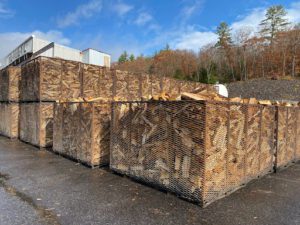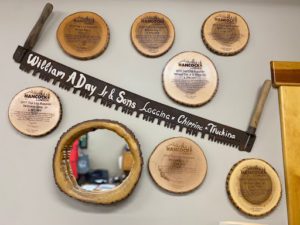Heating with firewood is an ancient practice. The first people to heat their living space by burning wood did so more than 300 millennia ago. We’ve come a very long way from campfires and burning deadfall as a serious source of residential heating since then. Though the fundamentals haven’t really changed, the heating technologies we use now, even with firewood, are a lot more sophisticated. We wanted to take some time to educate our customers on what kinds of wood they should be using for various applications and provide some tips on how to use them best.
 The Kinds Of Firewood Available
The Kinds Of Firewood Available
Without getting into specifics of species, there are two main categories of wood: softwoods like pine, cedar, yew, and other evergreens, and hardwoods like oak, ash, apple, and other deciduous trees. Beyond these categories, how dry wood is makes a big difference to how effective it is as a source of heat, how dry your wood is is reflected by its description as green, seasoned or kiln-dried.
Softwoods
The pitch in softwoods makes them unsuited to burning indoors. Even though pitch is flammable and softwoods can burn quite hot even when only slightly seasoned, they leave a lot of sticky flammable residue behind in stoves and chimneys. This residue is called ‘creosote’ and it’s what leads to chimney fires that can lead to house fires. Making sure you minimize the amount of creosote you have inside your home heating system is very important to keeping your wood burning safe.
That said, softwoods can actually be a very useful source of heat if you’re under the open sky. They also can be good kindling if they’re sufficiently well seasoned, even for indoor fires. You just want to make sure you’re not burning a lot of softwood to avoid creosote build up. Many will use softwoods in bonfires, and they’re perfectly safe to use in fire pits that don’t have a chimney system. Since the smoke will be exhausted without an opportunity for creosote to condense, this is much safer than burning a softwood indoors. As with any outdoor fire, you’ll want to make sure that you keep it well controlled.
Softwood can be particularly spark-heavy due to the pitch it contains. When any kind of tree sap or moisture is in wood it can be forced to expand rapidly and cause a tiny explosion when they’re boiled into a gas. The drier the wood, the less of a problem this can be. As a precaution, you should make sure that there’s nothing flammable in a 5-foot radius of your firepit and that you have the means to douse any accidental ignitions outside that range.
Hardwood
Deciduous hardwood trees have much less sap than coniferous softwoods. Hardwoods are also significantly denser (and thus “hard”). These two facts make them much more suitable for burning indoors. The smoke from adequately seasoned hardwood imparts very minimal creosote to your chimney. While you can’t skip annual chimney cleanings, you run a much lower risk of a serious chimney fire if you burn only seasoned or kiln dried hardwood.
Hardwoods also have a higher total heat output compared to softwoods, making them more efficient for heating your home. Part of this improved burning is due to lower total moisture. THe moisture in your wood has to boil off, sapping heat energy that could otherwise radiate into your home. So, the less sap the better. The other big factor in heat output is the density of the wood. Fire generates heat through a chemical reaction centered around carbon. The more carbon a fuel source has, the more heat is produced by the chemical reaction. Most fossil fuels are nearly pure carbon by mass, which is why they’re used for heating.
Green Firewood
Green wood is generally considered to be unsuitable for burning either indoors or outdoors. Some furnace manufacturers and dealers claim their wood furnaces can burn green wood, and technically, they’re correct. However, when the ash from burnt wood mixes with the excessive moisture in green hardwood, it creates a corrosive mixture that can damage the furnace over time. Also, because so much moisture has to be boiled off, the green wood is typically less than half as efficient for generating heat.
Since green wood is less expensive than seasoned or kiln dried wood, you may be tempted to go with green wood anyway. If you’re planning on heating exclusively with firewood and need several cords of wood every year, you may want to buy green wood and stack it to season over the year(link to last month’s blog on stacking). This does require much more time, however you can save some money in exchange for the reduced convenience.
Seasoned Firewood
Seasoned firewood is the traditional choice for indoor burning. It produces little creosote, burns hot, and doesn’t have too much moisture. This makes it excellent firewood for all kinds of indoor burning. Wood furnaces also perform well with seasoned wood, as it’s about twice as efficient as green wood. The low moisture content of seasoned firewood also means that there’s less degradation of your wood stove or furnace since there’s less corrosive material produced.
Seasoned firewood is the standard option for indoor heating, and it’s great for low effort outdoor fires. It’s very easy to burn seasoned firewood logs with just a bit of good quality kindling to get it started, and it produces great coals for heating overnight and easily restarting your fire with a bit of tinder and more fuel.
Kiln-Dried
Kiln-dried firewood has only become widely available in the last few decades, though it has been used to some degree since the early 1800’s. You can think of kiln-dried wood as seasoned wood but better. It has less moisture, burns hotter, is more efficient, and produces virtually no creosote. This makes kiln-dried firewood the best kindling and overall choice for heating.
That said, kiln-dried wood does tend to be more expensive because energy must be used to heat and circulate air in the wood dry kiln. However, rather than taking one or two years to dry like seasoned wood, you can kiln dry green wood in just a few days! This makes kiln dried wood a more value-added product than seasoned wood.
Why Day Logging?
Often the best approach for homeowners who heat with wood is to get a mix of different grades of firewood. At Day Logging, we provide all these types of firewood for our customers, so you can get exactly what you want and need. Contact us today to find out more and place an order for the firewood you need.

